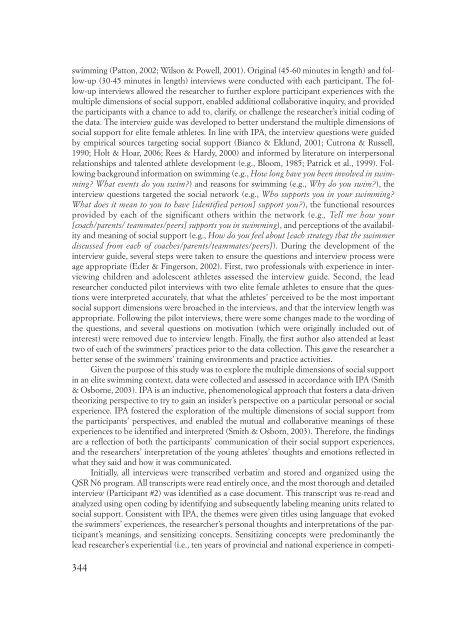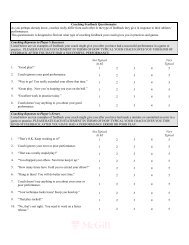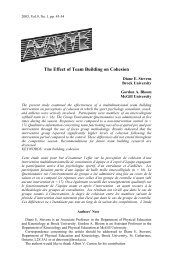International Journal of Sport Psychology
International Journal of Sport Psychology
International Journal of Sport Psychology
You also want an ePaper? Increase the reach of your titles
YUMPU automatically turns print PDFs into web optimized ePapers that Google loves.
swimming (Patton, 2002; Wilson & Powell, 2001). Original (45-60 minutes in length) and follow-up<br />
(30-45 minutes in length) interviews were conducted with each participant. The follow-up<br />
interviews allowed the researcher to further explore participant experiences with the<br />
multiple dimensions <strong>of</strong> social support, enabled additional collaborative inquiry, and provided<br />
the participants with a chance to add to, clarify, or challenge the researcher’s initial coding <strong>of</strong><br />
the data. The interview guide was developed to better understand the multiple dimensions <strong>of</strong><br />
social support for elite female athletes. In line with IPA, the interview questions were guided<br />
by empirical sources targeting social support (Bianco & Eklund, 2001; Cutrona & Russell,<br />
1990; Holt & Hoar, 2006; Rees & Hardy, 2000) and informed by literature on interpersonal<br />
relationships and talented athlete development (e.g., Bloom, 1985; Patrick et al., 1999). Following<br />
background information on swimming (e.g., How long have you been involved in swimming?<br />
What events do you swim?) and reasons for swimming (e.g., Why do you swim?), the<br />
interview questions targeted the social network (e.g., Who supports you in your swimming?<br />
What does it mean to you to have [identified person] support you?), the functional resources<br />
provided by each <strong>of</strong> the significant others within the network (e.g., Tell me how your<br />
[coach/parents/ teammates/peers] supports you in swimming), and perceptions <strong>of</strong> the availability<br />
and meaning <strong>of</strong> social support (e.g., How do you feel about [each strategy that the swimmer<br />
discussed from each <strong>of</strong> coaches/parents/teammates/peers]). During the development <strong>of</strong> the<br />
interview guide, several steps were taken to ensure the questions and interview process were<br />
age appropriate (Eder & Fingerson, 2002). First, two pr<strong>of</strong>essionals with experience in interviewing<br />
children and adolescent athletes assessed the interview guide. Second, the lead<br />
researcher conducted pilot interviews with two elite female athletes to ensure that the questions<br />
were interpreted accurately, that what the athletes’ perceived to be the most important<br />
social support dimensions were broached in the interviews, and that the interview length was<br />
appropriate. Following the pilot interviews, there were some changes made to the wording <strong>of</strong><br />
the questions, and several questions on motivation (which were originally included out <strong>of</strong><br />
interest) were removed due to interview length. Finally, the first author also attended at least<br />
two <strong>of</strong> each <strong>of</strong> the swimmers’ practices prior to the data collection. This gave the researcher a<br />
better sense <strong>of</strong> the swimmers’ training environments and practice activities.<br />
Given the purpose <strong>of</strong> this study was to explore the multiple dimensions <strong>of</strong> social support<br />
in an elite swimming context, data were collected and assessed in accordance with IPA (Smith<br />
& Osborne, 2003). IPA is an inductive, phenomenological approach that fosters a data-driven<br />
theorizing perspective to try to gain an insider’s perspective on a particular personal or social<br />
experience. IPA fostered the exploration <strong>of</strong> the multiple dimensions <strong>of</strong> social support from<br />
the participants’ perspectives, and enabled the mutual and collaborative meanings <strong>of</strong> these<br />
experiences to be identified and interpreted (Smith & Osborn, 2003). Therefore, the findings<br />
are a reflection <strong>of</strong> both the participants’ communication <strong>of</strong> their social support experiences,<br />
and the researchers’ interpretation <strong>of</strong> the young athletes’ thoughts and emotions reflected in<br />
what they said and how it was communicated.<br />
Initially, all interviews were transcribed verbatim and stored and organized using the<br />
QSR N6 program. All transcripts were read entirely once, and the most thorough and detailed<br />
interview (Participant #2) was identified as a case document. This transcript was re-read and<br />
analyzed using open coding by identifying and subsequently labeling meaning units related to<br />
social support. Consistent with IPA, the themes were given titles using language that evoked<br />
the swimmers’ experiences, the researcher’s personal thoughts and interpretations <strong>of</strong> the participant’s<br />
meanings, and sensitizing concepts. Sensitizing concepts were predominantly the<br />
lead researcher’s experiential (i.e., ten years <strong>of</strong> provincial and national experience in competi-<br />
344




